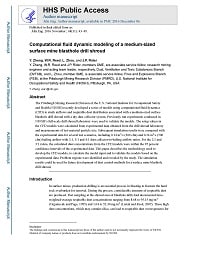Mining Publication: Computational Fluid Dynamics Modeling of a Medium-sized Surface Mine Blasthole Drill Shroud
Original creation date: November 2016
Authors: Y Zheng, WR Reed, L Zhou, JP Rider
The Pittsburgh Mining Research Division of the U.S. National Institute for Occupational Safety and Health (NIOSH) recently developed a series of models using computational fluid dynamics (CFD) to study airflows and respirable dust distribution associated with a medium-sized surface blasthole drill shroud with a dry dust collector system. Previously run experiments conducted in NIOSH’s full-scale drill shroud laboratory were used to validate the models. The setup values in the CFD models were calculated from experimental data obtained from the drill shroud laboratory and measurements of test material particle size. Subsequent simulation results were compared with the experimental data for several test scenarios, including 0.14 m3/s (300 cfm) and 0.24 m3/s (500 cfm) bailing airflow with 2:1, 3:1 and 4:1 dust collector-to-bailing airflow ratios. For the 2:1 and 3:1 ratios, the calculated dust concentrations from the CFD models were within the 95 percent confidence intervals of the experimental data. This paper describes the methodology used to develop the CFD models, to calculate the model input and to validate the models based on the experimental data. Problem regions were identified and revealed by the study. The simulation results could be used for future development of dust control methods for a surface mine blasthole drill shroud.

- Development and Application of Reservoir Models and Artificial Neural Networks for Optimizing Ventilation Air Requirements in Development Mining of Coal Seams
- A Gas Pressure-Based Drift Round Blast Design Methodology
- Modeling and Prediction of Ventilation Methane Emissions of U.S. Longwall Mines Using Supervised Artificial Neural Networks
- Modernization and Further Development of the NIOSH Mine Emergency Response Training System (MERITS), Phase 1
- SPONCOM - A Computer Program for the Prediction of the Spontaneous Combustion Potential of an Underground Coal Mine
- SponCom - Spontaneous Combustion Assessment Software - 2.0
- Technology News 509 - A New Method to Clean Dust From Soiled Work Clothes
- Technology News 545 - NIOSH Updates Spontaneous Combustion Assessment Software
- Technology News 549 - MFIRE 3.0 - NIOSH Brings MFIRE into 21st Century
- Toolbox Training on Flyrock Awareness